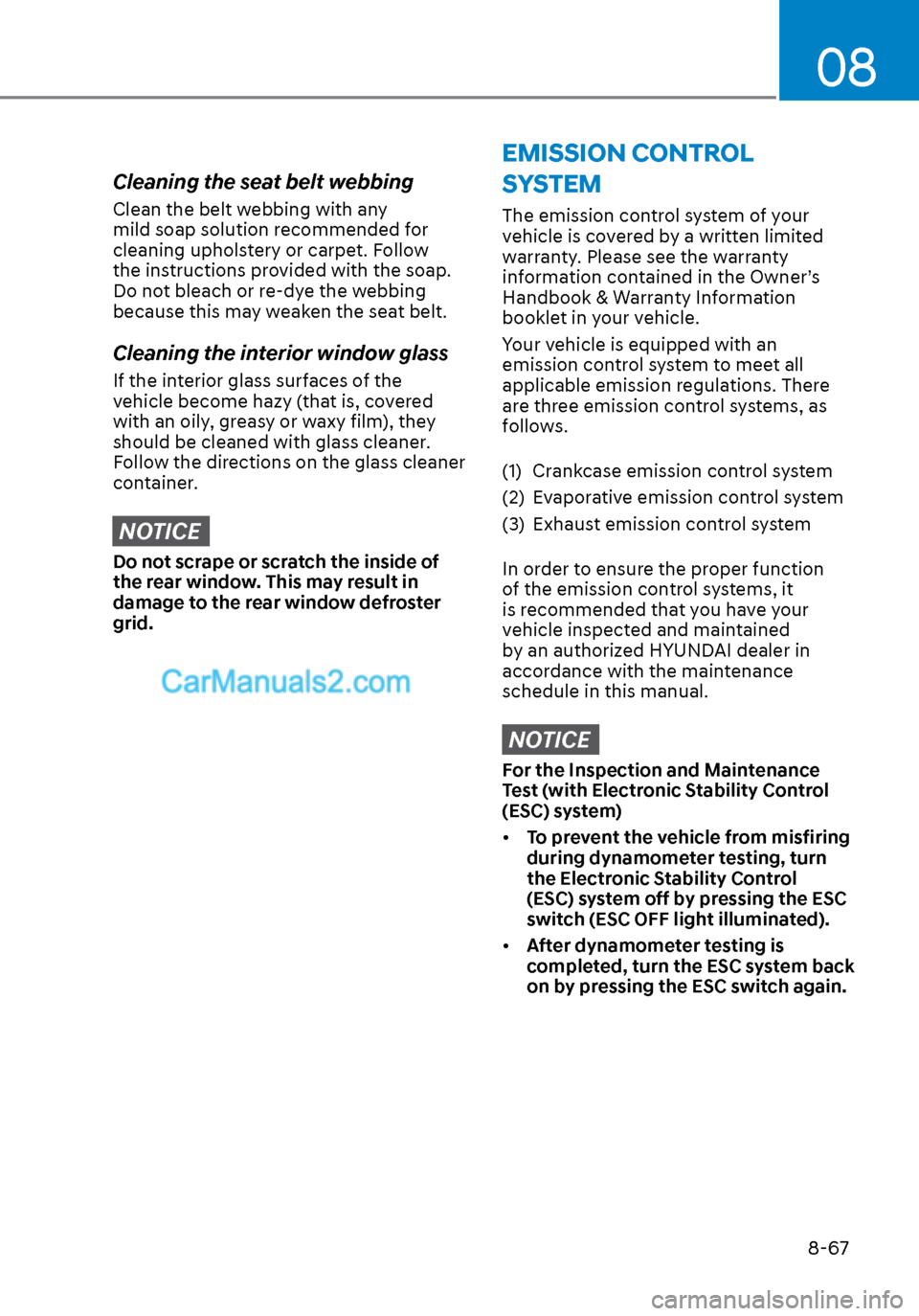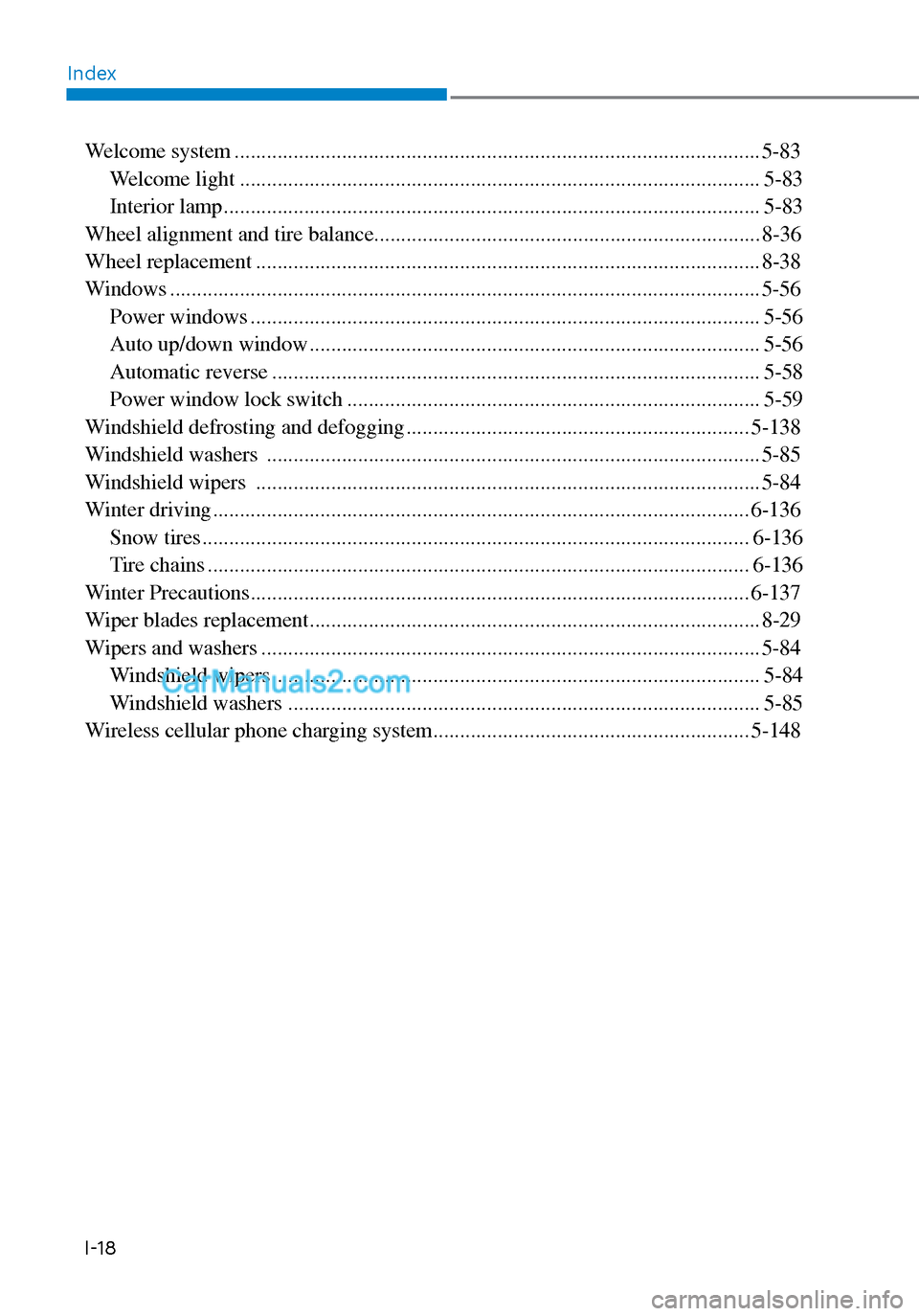2020 Hyundai Sonata Window
[x] Cancel search: WindowPage 500 of 537

08
8-53
Engine compartment fuse panel
Fuse Name (A)Circuit Protected
MULTI
FUSE
-1 IG2 30A E/R Junction Block (Start Relay), PCB Block (IG2 Relay)
BLOWER 40A E/R Junction Block (Blower Relay) ABS1 40A ESC ModuleB+2 50A ICU Junction Block (IPS4, IPS3, IPS1, Fuse - AMP, IBU1)
PTC HEATER 50A E/R Junction Block (PTC Heater Relay) B+3 50A ICU Junction Block (IPS5, IPS7, IPS9, IPS10, IPS8, IPS6)
OIL PUMP1 50A Electronic Oil Pump COOLING FAN 80A Cooling Fan Motor
MDPS 80A MDPS Unit
MULTI
FUSE-2 E-SHIFTER 30A SCU
E-CVVT1 40A [G4FN] CVVD ACTUATOR
[====] E/R Junction Block (E-CVVT Relay)
IG1 40A PCB Block (IG1 Relay, ACC Relay)
REAR
HEATED 50A E/R Junction Block (Rear Heated Relay)
EPB 60A ESC Module B+5 60A PCB Block (Engine Control Relay, Fuse - A/C1,
WIPER1, TCU1, HORN, ECU2)
B+1 60A ICU Junction Block (Fuse - P/SEAT (DRV),
P/SEAT (PASS), MODULE1, SAFETY P/WINDOW (LH),
SAFETY P/WINDOW (RH), S/HEATER (RR))
Page 508 of 537

08
8-61
Exterior Care
Exterior general caution
It is very important to follow the label
directions when using any chemical
cleaner or polish. Read all warning and
caution statements that appear on the
label.
High-pressure washing
• When using high-pressure washers, make sure to maintain sufficient
distance from the vehicle. Insufficient
clearance or excessive pressure can
lead to component damage or water
penetration.
• Do not spray the camera, sensors or its surrounding area directly with a
high pressure washer. Shock applied
from high pressure water may cause
the device to not operate normally.
• Do not bring the nozzle tip close to boots (rubber or plastic covers) or
connectors as they may be damaged
if they come into contact with high
pressure water.
• Do not use any high-pressure nozzles, which induce either one-direct water
stream or water swirling.
Protecting your vehicle’s finish
Washing
To help protect your vehicle’s finish from
rus
t and deterioration, wash it thoroughly
and frequently at least once a month
with lukewarm or cold water.
If you use your vehicle for off-road
driving, you should wash it after each
off-road trip. Pay special attention to the
removal of any accumulation of salt, dirt,
mud, and other foreign materials. Make
sure the drain holes in the lower edges
of the doors and rocker panels are kept
clear and clean.
Insects, tar, tree sap, bird droppings,
industrial pollution and similar deposits
can damage your vehicle’s finish if not
removed immediately.
Even prompt washing with plain water
may not completely remove all these
deposits. A mild soap, safe for use on
painted surfaces, should be used.
After washing, rinse the vehicle
thoroughly with lukewarm or cold water.
Do not allow soap to dry on the finish.
WARNING
After washing the vehicle, test the
brakes while driving slowly to see
if they have been affected by water
before getting on the road. If braking
performance is impaired, dry the
brakes by applying them lightly while
maintaining a slow forward speed.
NOTICE
• Do not use strong soap, chemical
detergents or hot water, and do not
wash the vehicle in direct sunlight
or when the body of the vehicle is
warm.
• Be careful when washing the side
windows of your vehicle.
Especially, with high-pressure water,
water may leak through the windows
and wet the interior.
• To prevent damage to the plastic
parts, do not clean with chemical
solvents or strong detergents.
APPEARANCE CARE
Page 514 of 537

08
8-67
Cleaning the seat belt webbing
Clean the belt webbing with any
mild soap solution recommended for
cleaning upholstery or carpet. Follow
the instructions provided with the soap.
Do not bleach or re-dye the webbing
because this may weaken the seat belt.
Cleaning the interior window glass
If the interior glass surfaces of the
vehicle become hazy (that is, covered
with an oily, greasy or waxy film), they
should be cleaned with glass cleaner.
Follow the directions on the glass cleaner
container.
NOTICE
Do not scrape or scratch the inside of
the rear window. This may result in
damage to the rear window defroster
grid.
EMISSION CONTROL
SYSTEM
The emission control system of your
vehicle is covered by a written limited
warranty. Please see the warranty
information contained in the Owner’s
Handbook & Warranty Information
booklet in your vehicle.
Your vehicle is equipped with an
emission control system to meet all
applicable emission regulations. There
are three emission control systems, as
follows.
(1) Crankcase emission control system
(2) Evaporative emission control system
(3) Exhaust emission control system
In order to ensure the proper function
of the emission control systems, it
is recommended that you have your
vehicle inspected and maintained
by an authorized HYUNDAI dealer in
accordance with the maintenance
schedule in this manual.
NOTICE
For the Inspection and Maintenance
Test (with Electronic Stability Control
(ESC) system)
• To prevent the vehicle from misfiring
during dynamometer testing, turn
the Electronic Stability Control
(ESC) system off by pressing the ESC
switch (ESC OFF light illuminated).
• After dynamometer testing is
completed, turn the ESC system back
on by pressing the ESC switch again.
Page 515 of 537

Maintenance8-68
1. Crankcase Emission Control System
The positive crankcase ventilation system
is employed to prevent air pollution
caused by blow-by gases being emitted
from the crankcase. This system supplies
fresh filtered air to the crankcase through
the air intake hose. Inside the crankcase,
the fresh air mixes with blow-by gases,
which then pass through the PCV valve
into the induction system.
2. Evaporative Emission Control System Including Onboard
Refueling Vapor Recovery
(ORVR)
The Evaporative Emission Control System
is designed to prevent fuel vapors from
escaping into the atmosphere. The
ORVR system is designed to allow the
vapors from the fuel tank to be loaded
into a canister while refueling at the gas
station, preventing the escape of fuel
vapors into the atmosphere.
Canister
Fuel vapors generated inside the fuel
tank are absorbed and stored in the
onboard canister. When the engine is
running, the fuel vapors absorbed in the
canister are drawn into the surge tank
through the purge control solenoid valve.
Purge Control Solenoid Valve (PCSV)
The purge control solenoid valve
is controlled by the Engine Control
Module (ECM); when the engine coolant
temperature is low during idling, the
PCSV closes so that evaporated fuel
is not taken into the engine. After the
engine warms-up during ordinary
driving, the PCSV opens to introduce
evaporated fuel to the engine.
3. Exhaust Emission Control System
The Exhaust Emission Control System is
a highly effective system which controls
exhaust emissions while maintaining
good vehicle performance.
When the engine starts or fails to start,
excessive attempts to restart the engine
may cause damage to the emission
system.
Engine exhaust (carbon monoxide)
precautions
• Carbon monoxide can be present
with other exhaust fumes. If you smell
exhaust fumes of any kind in your
vehicle, drive with all the windows
fully open. Have your vehicle checked
and repaired immediately.
WARNING
Engine exhaust gases contain carbon
monoxide (CO). Though colorless and
odorless, it is dangerous and could be
lethal if inhaled. Follow the instructions
on this page to avoid CO poisoning.
WARNING
CALIFORNIA PROPOSITION 65
WARNING
Engine exhaust and a wide variety of
automobile components and parts,
including components found in the
interior furnishings in a vehicle, contain
or emit chemicals known to the State
of California to cause cancer and
birth defects and reproductive harm.
In addition, certain fluids contained
in vehicles and certain products of
component wear contain or emit
chemicals known to the State of
California to cause cancer and birth
defects or other reproductive harm.
Page 531 of 537

IndexI-12
Manual climate control system ........................................................................\
.. 5-118 Heating and air conditioning ........................................................................\
. 5-119
Mode selection ........................................................................\
...................... 5-120
Instrument panel vents ........................................................................\
.......... 5-122
Temperature control ........................................................................\
.............. 5-122
Air intake control ........................................................................\
.................. 5-122
Fan speed control ........................................................................\
.................. 5-123
Air conditioning ........................................................................\
.................... 5-123
System operation ........................................................................\
................... 5-124
System maintenance ........................................................................\
.............. 5-125
Air conditioning refrigerant label......................................\
............................ 5-126
Mirrors ................................................................\
................................................. 5-46
Inside rearview mirror ........................................................................\
............. 5-46
HomeLink
® system.................................................................\
......................... 5-47
Side view mirrors ........................................................................\
.................... 5-53
Adjusting the side view mirrors ...................................................................... 5-54
Folding the side view mirrors ........................................................................\
. 5-54
Reverse parking aid function ........................................................................\
.. 5-55
N
Navigation-based Smart Cruise Control (NSCC) .............................................. 6-105
O
Occupant Classification System (OCS) ............................................................... 3-47
Odometer ...............................................................\
................................................ 4-5
Oil (Engine) ........................................................................\
................................. 8-19
Outside temperature gauge ........................................................................\
............ 4-5
Owner maintenance ........................................................................\
....................... 8-5
P
Panoramic sunroof ........................................................................\
....................... 5-60
Parking lamp position ........................................................................\
.................. 5-75
Passenger’s front air bag ........................................................................\
.............. 3-39
Power brakes ........................................................................\
................................ 6-20
Power outlet ........................................................................\
............................... 5-146
Power window lock switch ........................................................................\
.......... 5-59
Pre-tensioner seat belt ........................................................................\
.................. 3-24 Retractor pretensioner ........................................................................\
............. 3-24
Page 537 of 537

IndexI-18
Welcome system ........................................................................\
.......................... 5-83 Welcome light ........................................................................\
......................... 5-83
Interior lamp ........................................................................\
............................ 5-83
Wheel alignment and tire balance........................................\
................................ 8-36
Wheel replacement ........................................................................\
...................... 8-38
Windows .................................................................\
............................................. 5-56 Power windows ........................................................................\
....................... 5-56
Auto up/down window ........................................................................\
............ 5-56
Automatic reverse ........................................................................\
................... 5-58
Power window lock switch ........................................................................\
..... 5-59
Windshield defrosting and defogging ................................................................ 5-138
Windshield washers ........................................................................\
.................... 5-85
Windshield wipers ........................................................................\
...................... 5-84
Winter driving ........................................................................\
............................ 6-136 Snow tires ........................................................................\
.............................. 6-136
Tire chains ........................................................................\
............................. 6-136
Winter Precautions ........................................................................\
..................... 6-137
Wiper blades replacement ........................................................................\
............ 8-29
Wipers and washers ........................................................................\
..................... 5-84 Windshield wipers ........................................................................\
.................. 5-84
Windshield washers ........................................................................\
................ 5-85
Wireless cellular phone charging system ........................................................... 5-148